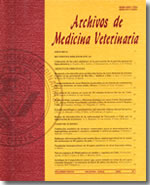Characterization and evaluation of the stunning systems used for horses in Chile
Main Article Content
Abstract
General information on the stunning systems used for horses was collected and 333 horses were observed and scored during slaughter in three slaughterplants in order to evaluate the efficiency of the process, registering: number of attempts required to induce insensibility, presence of return to sensibility signs and stun to stick time; also 100 heads were inspected in order to determine the location of the lesions on the skulls respect to the ideal shooting position. In plant A a non penetrating captive bolt pistol was used, impelled by cartridges with gunpowder; in plant B a penetrating captive bolt pistol was used, that was impelled through a pneumatic system; in plant C the horses were stunned using electricity applied to the forehead by means of a stick with only one electrode at its end. In plants A, B and C respectively, only 76.6%, 78.2% and 2.9% of the horses were stunned at the first attempt, the percentage of horses without signs of return to sensibility was 89.1%, 82.2% and 96.2%, and the percentage of horses that were actually bled within one minute after stunning was 84.4%, 5.0% and 66.3%. When the location of the lesions on the skull was measured respect to the ideal shooting position in plants A and B, it was found that 33.3% and 11.5% of the shots hit the target (within 2 cm). It was concluded that there is a low efficiency in the stunning process of horses and that its main objective, that the animals do not suffer unnecessary pain during slaughter, is not achieved.

